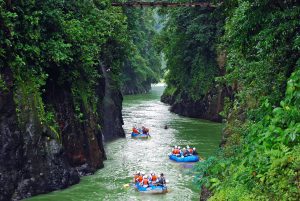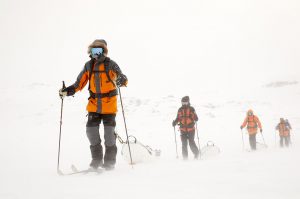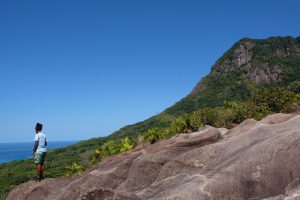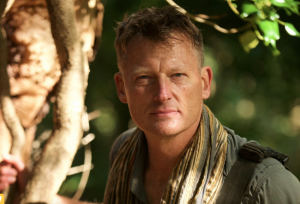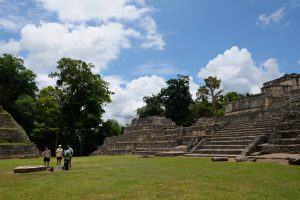
Caribbean beach towns cradled by an almighty barrier reef and showstopping Maya citadels half-buried in rainforest are among Belize’s crown jewels. But a journey through the small Central American nation reveals hidden facets, too.
Read online at nationalgeographic.com
The skies have opened over the rugged foothills of the Maya Mountains, the first deluge of the rainy season breaking the forest’s sticky heat with a tide of fast, fat droplets.
It draws a gauzy veil across the landscape, dulling the daylight that just moments before warmed the deck of my riverfront cabin, and fills the valley with a peculiar, powerful percussion. Rain ricochets off waxy foliage, drums onto craggy rocks and hammers against my body. A scent is rising from the earth in response to the water: something musty and mineral I wish I could bottle. Cowering from the storm, I watch almighty nature in conversation with itself; thunder answering lightning, streams feeding the banks of the thirsty Macal River. When, at dawn, the weather wears itself out, the sun reappears and the birds take up their chorus, it feels like something in the world has reset. It’s a dramatic welcome to the wild, western flank of Belize.
“Later in the season, when the river rises so high it floods this road, we just canoe the guests across — or put up zip-lines between the trees,” my guide Fernando Obando tells me as we navigate a water-logged road away from Black Rock Lodge in his 4×4. “We don’t stop for a little rain.” The off-grid collection of cabins, powered by water turbines and a new rack of solar panels, is a stalwart of the country’s blossoming ecotourism scene and a hotspot for birders in the know. But today we’re heading several hours south.
Fernando drives us on rough roads through ranchland towards Mountain Pine Ridge Forest Reserve, home to yawning caves that snake into the granite massif, waterfalls that trip over lofty cliffs and a complex of freshwater pools where we stop off to swim. Further still, at the end of a rutted jungle track, lies our final destination: an ancient Maya site so vast and significant it could upstage Guatemala’s Tikal or Mexico’s Chichén Itzá. If only more people had heard of it.
“Welcome to the city of Caracol,” Fernando says grandly, as we walk into a grassy plaza. “This kingdom conquered many others, including mighty Tikal, rising to become the superpower in the region in the eighth century; 100,000 people would’ve called it home at its peak — that’s twice the size of Belize’s largest city today.” Fernando lets silence fall between us as I take in the scale of the structure in front of us: Caana, also known as the Sky Palace, a humbling, pyramidal complex of soaring stairs, temples, burial chambers and royal living quarters. It would have placed Caracol’s rulers 139ft high, above the forest canopy, at the top of the known world. Today, it’s still the tallest man-made structure in Belize.
While heavy footfall at Latin America’s other major archaeological sites often means structures are roped off, here we’re free to climb the excavated building, which we do, crawling like penitent courtiers up its steep and uneven central steps. The panorama from on high reveals an undulating horizon — split into the deep emerald of the forest and a banner of bright, blue sky — while just below us, more stone palaces fan out. “A lot of what you’re seeing has only been uncovered in the past few decades, after a long sleep in the jungle. It would have been consumed quickly after it was abandoned, around a thousand years ago,” Fernando says. “In the tropics, if you leave something for a month, you’ll be surprised; nature takes over.” He remembers a surge of archaeological activity at Caracol at the turn of the millennium, when he was working here as a young park ranger: part of a major push funded by the Belize Tourism Development Project to ‘tourist-proof’ the largest of the ruins — stabilising buildings, tearing back creepers and clearing paths through the ancient city.
We continue onwards, Fernando weaving us through ancient ball courts and past astronomy centres, around the vast buttresses of ceiba trees and up onto more tall temples, some carved with the faces of fearsome deities. The solitude makes for glorious exploring — there are no kiosks, no vendors, no crowds. The quiet allows us to hear the guttural cries of howler monkeys in the forest; the space allows us to spot shards of clay pottery in the earth. “The government needs to finish paving the road to Caracol if we want more people to be able to access this,” Fernando says, lamenting delays caused by the pandemic. “There’s so much more to uncover here, if we had the interest. The ancient Maya have much to teach us.”
Into the jungle
Up close and by torchlight, the unblinking eyes of a crocodile are utterly unnerving. Of course, I should be more concerned about its jaws; the 6ft-long reptile has just been snared and pulled aboard our small boat. But I’m in safe hands: Eduardo Ruano, the man muzzling the beast, has been collecting data about Morelet’s crocodiles in northern Belize’s New River for over a decade, working with the University of Florida to map the species’ territory and distribution. Christian Ramirez, by his side, quickly laying out the research equipment, is no stranger to wrangling crocodiles in the dead of night either. By the beams of our headlamps, I take in the details of the animal’s face, the scales on her neck, her lizard arms, the girth of her tail. “You’re looking at a living fossil, right here,” Eduardo says.
Just minutes earlier, we’d been motoring down the dark river, a hot breeze in our faces, when our searchlight flashed upon a pair of reflective eyes in the shallows. The boat edged closer, Eduardo steadied himself on the prow and a loop was expertly slid over our crocodile’s neck. A line was then held slack until she exerted every ounce of her energy on a series of ‘death roll’ spins, a terrifying ballet typically used to thrash prey apart. Now, she’s in a temporary state of torpor, as pliant as a rag doll. “It’s rare for us to find one this size that we haven’t tagged before,” Christian says, the scanner in his hand finding no microchip. He tells me we’ll need to record her measurements and our geolocation and then plant one behind her right back leg. “We need to work fast before she regains her strength. Here, grab this pen.”
Experiences like this are part of what makes Lamanai Outpost Lodge a unique place to stay. A luxury compound of wooden pavilions abutting an ancient Maya city and a picturesque lagoon, it hosts long-term research projects into bats, jaguars and crocodiles in conjunction with foreign universities — most of which travellers can get involved with.
Studying the crocs is particularly interesting, Eduardo explains; testing the blood of top predators reveals the health of the ecosystem. Until a decade ago, results were still showing the lingering effects of the modern pesticide DDT — a hazardous chemical attributed to British colonists, who ran mahogany plantations in Belize’s interior for much of the 18th, 19th and 20th centuries. “There’s a legend in these parts that if you go out on the lagoon during Holy Week, you see mutated beasts,” Christian says, adding in a whisper: “I once saw a crocodile with a huge head and a withered body. There are strange things in this jungle.”
The next day, we take a walk around the ruins of Lamanai — a name that, inspired by the lagoon’s long-standing reptilian inhabitants, comes from the Mayan for ‘sunken crocodile’ — and into nearby Indian Church, the village Christian grew up in. “We’re two hours’ drive from the nearest hospital, so we treat as much as we can with medicine handed down by the Maya,” he says, pointing out the properties of plants as we stroll between brightly painted bungalows. There’s aloe vera for stomach complaints, ti plant for headaches, hibiscus leaves for cramps and crepe jasmine to numb pain during dental work. There’s also a plant whose boiled roots buy snake-bite victims more time to get to A&E. “And the lime trees you see there, well those are mainly used for lemonade,” he says with a smile. We’ve arrived for lunch at Las Orquideas Restaurant, run by a collective of local women, serving up tamales and tortillas — using methods that would’ve been commonplace millennia ago.
The recipes may be ancient but this village, like much of Belize, has seen a lot of change in recent decades. “No one here considers themself pure-blooded Maya anymore; there’s been so much mixing and immigration,” Christian says as we watch the chefs in the kitchen pummelling corn on a metate grinding stone. “And many people moved away when the village was relocated in 1992, when the government created the archaeological park around the ruins. But a lot of the culture lives on.”
While most of Belize’s population of 405,000 consider themselves Latino or Creole, the Indigenous Maya still make up a significant minority of 10%. “It’s why the government picked the toucan to be our national bird when we became independent in 1981,” says Christian. “Its rainbow colours represent all the different people who call Belize home.”
Another group that make their presence felt in Belize are the Mennonites, ultra-conservative Protestants who date back to Europe’s 16th-century Reformation, often mistaken for the Amish. Since the 1950s, a population of 12,000 has bloomed in Belize, arriving from settlements in Mexico and carving thriving farming communities out of the dense jungle, with very limited modern technology. “I bought 50 acres, and it took me six years to clear it with my hands,” Cornelius Schmitt tells me when Christian and I meet him, his wife Anna and one of their grandchildren, Margarita, on their porch. Cornelius is fair-haired and blue-eyed and sporting a distinctive Mennonite look: denim overalls, plaid shirt and a straw hat. “Corn, sorghum, soy — those are my crops. We’re hard-working people,” he says. Today, the small group are the biggest contributors of vegetables, dairy and poultry to Belize’s economy, also turning their hand to beekeeping and crafting tools.
Although the Mennonites are famously insular, shunning modern society in favour of a quieter life, Cornelius enjoys welcoming travellers into his home for schnitzel and board games, and driving them around the settlement in his horse and buggy. Stopping at the local schoolhouse, we watch children learn grammar from a blackboard, study the New Testament and sing prayers in Plattdeutsch (the Low German dialect of the Mennonites). But if the school feels lost in time, the local pharmacy, by contrast, seems firmly of the 21st century, stocking every modern medicine under the sun. “To some extent, different Mennonite communities are able to adapt their own rules about engaging with the modern world,” Christian explains. “The most important thing for them is that they’re given space to live as they please. We’re proud of that in Belize.”
On the Caribbean coast
Usually, a pilot on a domestic flight wouldn’t double as a tour guide, but the four-seater, single-engine Cessnas that serve my route down to the southern coast allow for a fair amount of interaction. The man at the controls is tapping on his window, alerting me to Belize’s second-highest mountain. Below us, the clenched fist of Victoria Peak punches some 3,687ft out of the Cockscomb Basin Forest Reserve. Unlike in the agricultural regions of the north, where I’d seen forest flattened for rectilinear crop fields, here in the south the greenery looks wild and varied, a blanket punctuated only by the thin, white scars of waterfalls. Founded in 1990 as the world’s first jaguar reserve, today Cockscomb is home to one of the most sizeable population of jaguars outside the Amazon — and the park is just one of many conservation success stories in a country making significant strides to safeguard its natural riches.
Just last year, Belize’s protected lands grew to an impressive 40% of its total landmass. Meanwhile, the government committed to doubling its marine reserves to cover 30% of its ocean territory by 2026 with the support of the world’s largest ‘blue bonds’ debt-restructuring deal. It’s a savvy move: half of Belize’s population live along the Caribbean coast, relying on healthy marine ecosystems for their livelihoods. In the village of Seine Bight — perched on the edge of the half-moon Placencia Peninsula and home to a community of Afro-Indigenous Garifuna people — this includes the family of Austin ‘Bobby’ Sanchez and Kim Nuñez.
“We’ll take you fishing out on the lagoon later, if you like,” Kim says, as we grate coconut flesh in the shade of her lean-to kitchen. “Spot some manatees, enjoy the sunset with a rum punch; it’s the thing to do here, for sure.” The couple are showing me how to make hudut, the fragrant Garifuna fish stew — scaling freshly caught snook, plucking herbs and jalapeños from their little garden and pulverising boiled plantains in a carved tub with a heavy, 4ft-long pestle. Bobby does most of the cooking for their four children, an unusual reversal of gender roles here in Belize, I’m told. “Times are changing,” he laughs, bringing the simmering hudut pot from his wood-burning stove over to the dining table and taking off his apron.
Their home is decorated with handmade treasures: shell adornments designed to be strapped to the knees and jangle musically during traditional dances; big, wooden drums topped with taut animal skins. Garifuna is a culture so unique it was listed by UNESCO as a Masterpiece of the Oral and Intangible Heritage of Humanity in 2001. “Bobby is one of the best drummers in the whole of Belize,” Kim says proudly, pushing a drum towards me after lunch. “And a really good teacher.” He gets me to tap out a resonant beat, expertly improvising over the top of it and patiently correcting my mistakes. “Just feel it,” he urges. Don’t let the brain get in the way.”
It’s not long until conversation turns to politics. “There are a lot of misconceptions about the Garifuna,” Bobby explains. “We Black Caribs were never enslaved; we date our ancestry back to the 14th century, when West African king Abubakari II landed in the Caribbean’s Windward Islands, the crew mixing with Indigenous Amerindians such as the Arawak and the Kalinago.” The arrival of the British in the Windward Island of Saint Vincent in the 1700s saw the native population violently exiled from their homeland, a first group of settlers eventually reaching Belize in 1802. “They wanted to wipe us off the map. But we’re not going anywhere.” Understandably, Bobby wasn’t among those welcoming the Duke and Duchess of Cambridge to Belize when they toured a nearby Garifuna village in March, part of a charm offensive in the Caribbean’s Commonwealth nations in the Queen’s jubilee year. “We need to talk about the wrongs done, about reparation. You can’t look forward until you look back,” says Bobby.
Barrier reef rescue
I have one final stop on my journey through Belize, one that speeds me towards the horizon by water taxi, docking at the largest of the country’s 400 islets. Ambergris Caye is every bit the Caribbean dream: white-sand beaches, colourful wooden houses and picturesque mangroves. And if the pace of life in Seine Bight felt laid-back, the town of San Pedro offers travellers something close to horizontal. A place to throw away your shoes and your watch. To hire an electric golf buggy and drive to secret coves. To watch the sunset from over-water wooden bars on stilts. But for all this scenery, the true show lies beneath the waves, just offshore: Belize’s most important natural asset, the world’s second-largest barrier reef.
Stretching 170 miles around coastal lagoons, dunes and coral atolls, the reef is home to a staggering 1,400 species of flora and fauna — 77 of which are deemed ‘threatened’ by the International Union for Conservation of Nature. The section I’ve come to explore is Hol Chan Marine Reserve, ‘hol chan’ being Mayan for ‘narrow channel’. Historically, only skilled mariners were able to navigate through the reef breaks here without getting shipwrecked.
The underwater colours are kaleidoscopic: giant, copper branching corals; Tyrian-purple boulders; jade sea grass; and pink anemones. And the marine life is swarming — I hadn’t known the sea could be so busy. A trio of spotted eagle rays glide beneath me as I snorkel away from my dive boat with my guide, a local nicknamed Candyman who has the impressive ability to free dive to 40ft. “When other boys would play with toy cars or pellet guns, I was out here, finding caves in the coral and catching rides on nurse sharks,” he tells me.
As with anything this beautiful, the reef is fragile, lingering on UNESCO’s List of World Heritage in Danger from 2009 until 2018. The government didn’t take this lightly: an indefinite moratorium on offshore oil exploration, the banning of trawlers in Belizean waters and curbs on overfishing have mitigated the worst effects of mankind and restored its health to what I’m seeing today. A place where electric-blue damsel fish dance in vast shoals around my flippers and endangered hawksbill turtles surface to breathe just beside me. “Something most people don’t understand about the reef is that this ecosystem can’t stand alone,” Candyman tells me as we motor back towards my hotel’s jetty. “Without healthy mangrove swamps, for example, this will all die. In nature, everything is more connected than you know.” I think back to the rain-doused jungle I’d explored in the country’s west, the river systems I’d sailed through in the north and the lush mountain range I’d flown over in the south. Ancient habitats, in conversation with themselves and with each other, cradling spectacular wildlife and unique cultures — all worth fighting to protect.
Published in the October 2022 issue of National Geographic Traveller (UK)





